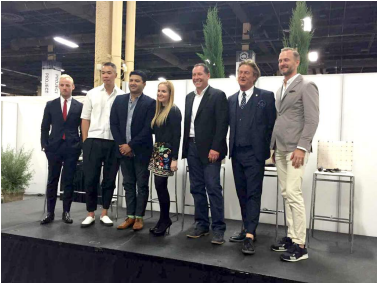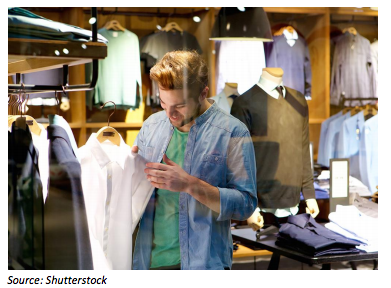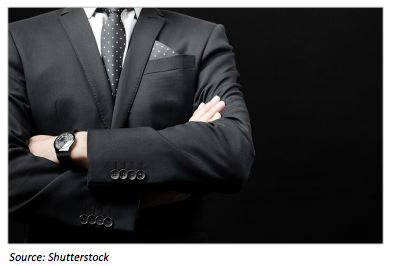| Read on fbicgroup.com |
 |
| Download PDF |
3 KEY TAKEAWAYS
- The panelists agreed that the consumer, particularly in menswear, is not brand loyal. While that may create challenges for brands, they have an opportunity to utilize data to gain a deep understanding of, and to better target, their customers.
- Pricing is down across men’s categories, and there is a glut of basics, the panelists said. So, retailers must be creative in communicating value to consumers. One example of that is calculating potential cost per wear, as GQ magazine has done for some items.
- Men are taking more risks on the fashion side and are shopping more for themselves versus having women shop for them. One of the panelists sees opportunity for men to outshop women in e-commerce channels down the line.
 Fung Global Retail & Technology and First Insight hosted a Breakfast with The Disruptors event at the PROJECT Las Vegas conference in conjunction with P1VOT, which is PROJECT’s new show floor area highlighting innovative, tech-based business solutions for designers and retailers in every category from manufacturing to merchandising. The event was the second PROJECT P1VOT panel we hosted in collaboration with First Insight. P1VOT was founded by Erik Ulin, President of Men’s at UBM Fashion Group, and Luis Fernandez, CFDA Member and Creative Director for menswear brand Craft Atlantic.
Fung Global Retail & Technology and First Insight hosted a Breakfast with The Disruptors event at the PROJECT Las Vegas conference in conjunction with P1VOT, which is PROJECT’s new show floor area highlighting innovative, tech-based business solutions for designers and retailers in every category from manufacturing to merchandising. The event was the second PROJECT P1VOT panel we hosted in collaboration with First Insight. P1VOT was founded by Erik Ulin, President of Men’s at UBM Fashion Group, and Luis Fernandez, CFDA Member and Creative Director for menswear brand Craft Atlantic.
In advance of this event, we teamed with First Insight to conduct a survey designed to gauge retail industry opinion on the holiday 2016 season—and the outlook is positive. See our full report here. Our first collaboration was last month at the Project Menswear conference in New York City. Please see the panel highlights here.
Ulin, of UBM Fashion Group, kicked off the breakfast session. Deborah Weinswig, Managing Director of Fung Global Retail & Technology, moderated the panel discussion at PROJECT. The panelists included Greg Petro, CEO and Founder, First Insight; Nelson Mui, VP, Men’s Fashion Director, Hudson’s Bay Company and Lord & Taylor; Nick Graham, CEO, Nick Graham Organization; Matthew Sebra, Digital Style Director, GQ; and Karthik Sridhar, CEO and Founder, Supply.AI.
The discussion centered on the menswear market and covered a wide range of topics. Below are our key takeaways from the panel discussion.
The Consumer Is Not Brand Loyal, but How Can Retailers Take Advantage of That?
Lord & Taylor is working with its vendors to create curated spaces that are more flexible and may be less brand specific, because millennial consumers are not as brand loyal as older generations, according to Mui. Today’s average consumer is younger, and millennials represent the largest workforce population in the US, at 75 million. Half of the population is under 35, and Gen Xers and Gen Zers combined total 148 million.
According to First Insight CEO Greg Petro, a powerful tool to combat the lack of brand loyalty is to have a very strong understanding of your customer at the microsegment level. In order to compete effectively, retailers have to understand the data they have access to at the very basic level, at a minimum. An understanding of the data will also enable manufacturers and retailers to offer a more targeted selection to their customers.
Psychographics are predictive of what consumers are going to do and what they are going to spend, while demographics are based in historical information. If two people do yoga, one may want yoga clothing for its wicking characteristics and the other may want it for its fashion characteristics. Psychographics helps companies understand which consumer is likely to want the clothing for which reason. It helps companies understand why they are making certain products and who they are being made for, Petro said. Nick Graham further described psychographics as how people think and feel, referring to these perceptions and feelings as customers’ “emotional gross margin,” the “squishy stuff around the price point.”
 Retailers are also combating consumers’ lack of brand loyalty by targeting them on a more individual and personal level. Some companies are establishing in-store partnerships with brands and working with vendors to come up with concept brands that can be customized and personalized.
Retailers are also combating consumers’ lack of brand loyalty by targeting them on a more individual and personal level. Some companies are establishing in-store partnerships with brands and working with vendors to come up with concept brands that can be customized and personalized.
Pricing Down in the Men’s Category; Retailers Have to be Creative in Communicating the Value Message
Although men’s category unit prices are down, certain subcategories are up, and retailers need to understand which items in those subcategories customers want. Fung Global Retail & Technology’s and First Insight’s recent analysis revealed, for example, that men’s underwear prices are up 34% overall. A deeper dive into the data revealed that, within the category, it is men’s trunks that are driving the price increase. Petro said that 11% of all items that First Insight tests can actually carry a higher price, and that understanding the customer at a microsegment level is critical to figuring out what that customer is willing to pay.
Matthew Sebra of GQ said that men choose items based on cost per wear, and understanding the customer at this microsegment level is a strategy used by GQ. The magazine creates strategies around men’s lifestyle zones, and how different groups enjoy spending their free time. When looking at cost per use, the rationale is that a consumer can get a basic item anywhere, but if the item is a great classic that the wearer will get a lot of use from, then they may be more likely to buy it.
The Tie Is Not Dead; Men Taking More Risks in Fashion
Men are shopping for themselves and making their own fashion decisions more often than they used to; in 1990, for example, women purchased 80% of men’s underwear for them according to Graham.
Men are looking for different ways to express their identity through their clothing and they want to be more individualized. For example, men may be looking for one statement piece, perhaps a bomber jacket with an embroidered bird or a souvenir jacket.
 The panel discussed the future of men’s trends and agreed that the tie is not dead, although the ties in a man’s closet may be changing to reflect a more creative design as well as embroidery and embellishment. Men are becoming more empowered with their fashion decisions. The consensus among the panelists was that men’s fashion moves more slowly than women’s fashion does, but that the pace is quickening, especially in men’s suiting.
The panel discussed the future of men’s trends and agreed that the tie is not dead, although the ties in a man’s closet may be changing to reflect a more creative design as well as embroidery and embellishment. Men are becoming more empowered with their fashion decisions. The consensus among the panelists was that men’s fashion moves more slowly than women’s fashion does, but that the pace is quickening, especially in men’s suiting.
Karthik Sridhar of Supply.AI concluded that he believes men will outshop women online in the future.













